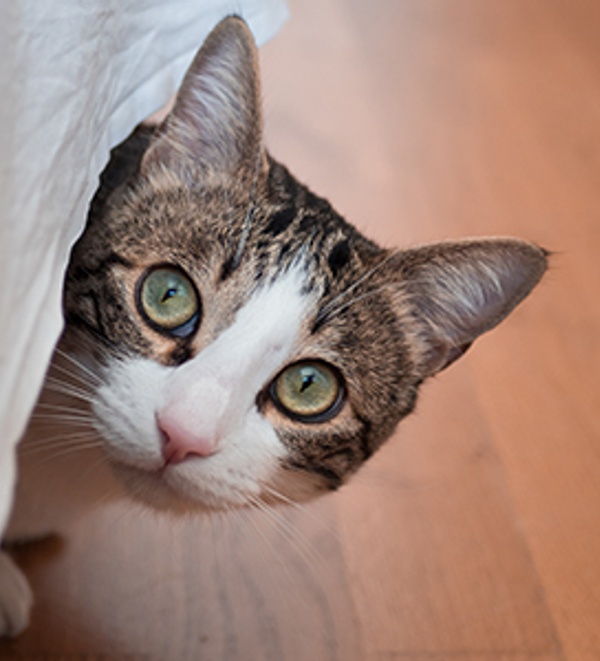
How to Calm an Anxious Cat: Tips Our Vets Want You to Know
Anxiety in cats can look different than it does in dogs. You might notice sudden aggression, hiding, excessive grooming, or even litter box issues. Whether your cat is showing signs of fear, stress, or reactivity, the good news is there’s help!
In this guide, our veterinary team breaks down the causes of feline anxiety and aggression, how to spot the signs, and which calming remedies and training techniques can make a difference.
COMMON SIGNS OF ANXIETY IN CATS
Feline anxiety can stem from new environments, loud noises, changes in routine, or even boredom. Here are some of the most common anxiety symptoms in cats:
Hiding more than usual
Excessive vocalization (meowing, yowling)
Litter box avoidance
Excessive grooming or bald patches
Aggressive behavior toward people or other animals
Destructive behavior (scratching, chewing)
Sudden changes in appetite or energy
While some signs may seem subtle, consistent changes in your cat’s behavior are worth noting—and addressing early.
TYPES OF AGGRESSION IN CATS
Not all aggression is the same. Understanding the cause of your cat’s behavior helps guide the right approach. Some of the most common types of aggression in cats include:
Fear Aggression
Fear aggression is triggered when a cat feels threatened. Signs include flattened ears, hissing, swatting, and hiding. Fear aggression training focuses on building trust and reducing triggers.
Territorial Aggression
Your cat may guard their space, especially when a new pet or person is introduced. Territorial aggression can lead to cat-on-cat aggression or even aggression toward humans.
Redirected Aggression
This happens when a cat sees something upsetting (like another animal outside) but lashes out at someone nearby instead. Redirected aggression in cats is often sudden and confusing.
Play Aggression
More common in kittens or young cats, play aggression includes biting, scratching, and pouncing. While normal, it’s important to teach boundaries through play aggression training and proper toys.
HOW TO HELP A STRESSED OR ANXIOUS CAT
Helping an anxious cat feel safe takes time and consistency. Here are our vet-approved steps you can take at home:
Create a Calm Environment
Start with the basics. Many cats may feel safer if they can escape to somewhere high and elevated from ground level, so perches are a great addition. Use calming pheromone sprays or diffusers, and reduce loud noises when possible.
Use Enrichment to Relieve Anxiety
Interactive toys, climbing structures, and puzzle feeders help relieve stress and boredom. For cats with separation anxiety, timed feeders and window perches can provide comfort during alone time.
Try Calming Remedies
There are several natural anxiety relief options for cats, including calming sprays, treats, and supplements. In more severe cases, your vet may recommend prescription anti-anxiety medications for cats.
Don’t Punish—Redirect
Punishment can increase fear and worsen behavior. Instead, redirect aggressive or anxious behavior with toys or distance, and reinforce calm moments with treats and praise.
Work with a Professional
For persistent aggression or anxiety, ask your vet about a behaviorist for cat aggression or reactive cat training. In-person or online training for aggressive cats can make a big difference, especially for fear-based aggressions.
WHEN TO CALL YOUR VET
If your cat’s behavior changes suddenly, becomes aggressive, or seems anxious all the time, schedule an appointment. There may be an underlying medical issue, and your vet can help tailor a treatment plan.
ASK THE VET: CAT ANXIETY & AGGRESSION FAQs
What are the signs of anxiety in cats?
Look for hiding, excessive grooming, vocalizing, aggression, or litter box issues. Anxious cats may also become withdrawn or stop eating.
How can I help my cat with anxiety?
Create a calm environment, offer interactive toys, and try pheromones or calming supplements. Talk to your vet about anti-anxiety medications if symptoms persist.
What causes aggression in cats?
Aggression may be due to fear, pain, play, or territory. Redirected aggression is also common, especially in indoor cats.
What’s the best treatment for aggressive cats?
It depends on the cause. For example, redirected aggression is treated differently than territorial aggression or petting-induced aggression. A behaviorist can help pinpoint triggers and design a plan.
Are there natural remedies for anxiety in cats?
Yes. Feline pheromone sprays, calming chews, and supplements with ingredients like L-theanine or tryptophan may help mild to moderate anxiety.
Can cats have separation anxiety?
Yes, feline separation anxiety is real—especially in cats that are very bonded to their person. Gradual desensitization, puzzle toys, and leaving on music or white noise can help.
My cat is suddenly aggressive toward my other cat. What should I do?
This may be feline non-recognition aggression or territorial behavior. Separate them temporarily, reintroduce slowly, and speak with your vet or a behaviorist for support.
Have more questions about anxiety in cats? Book an appointment with your vet to get personalized advice for your pet.
About the Author
